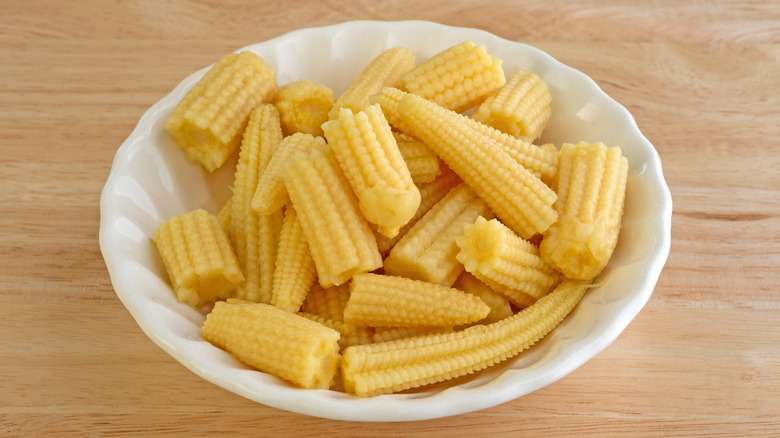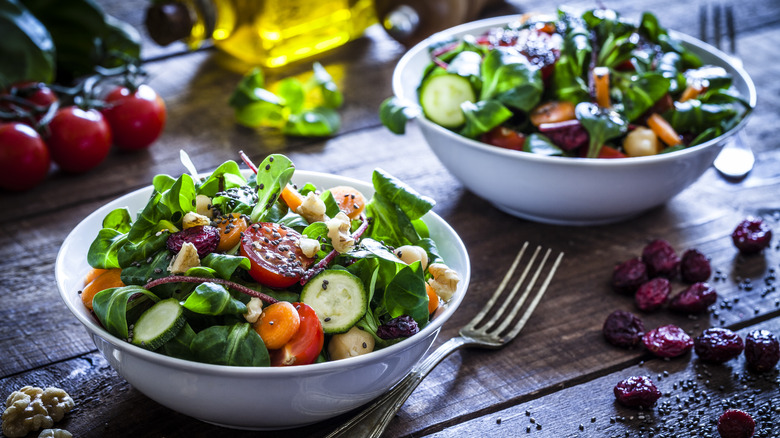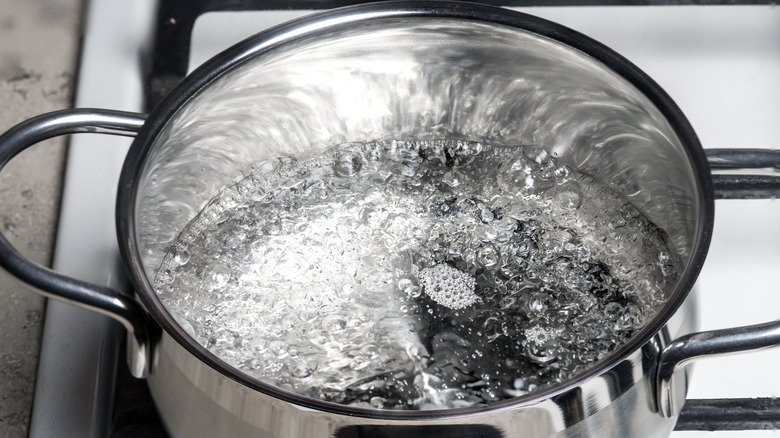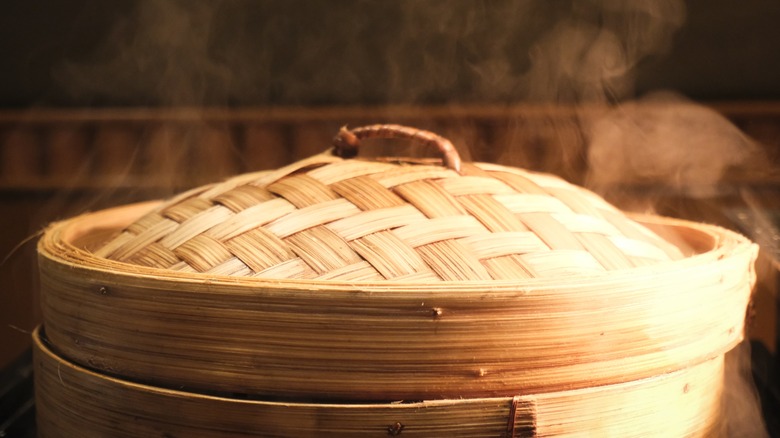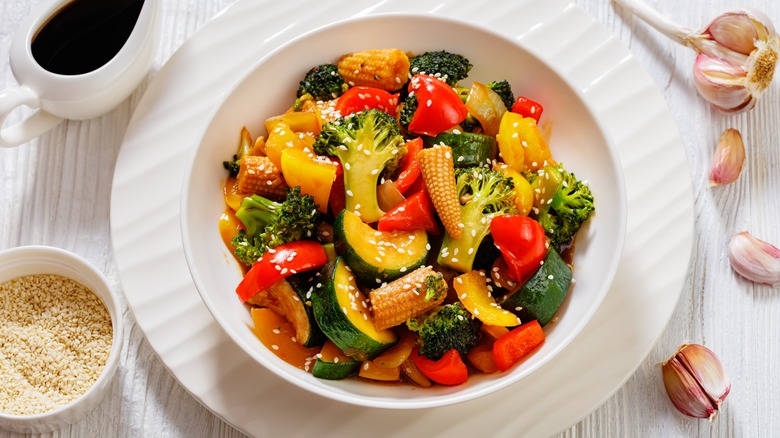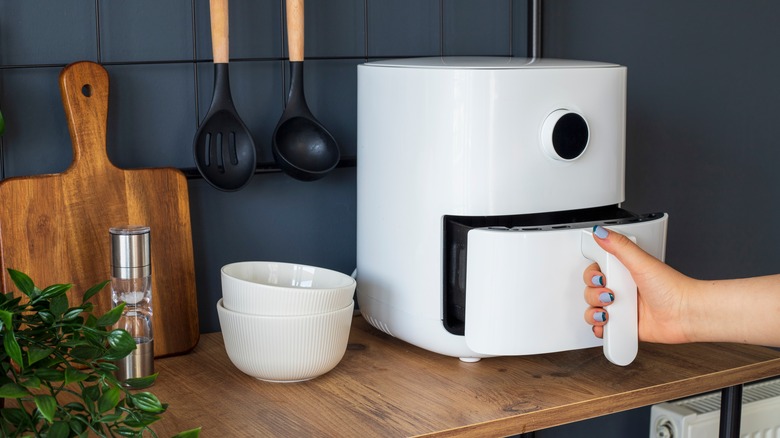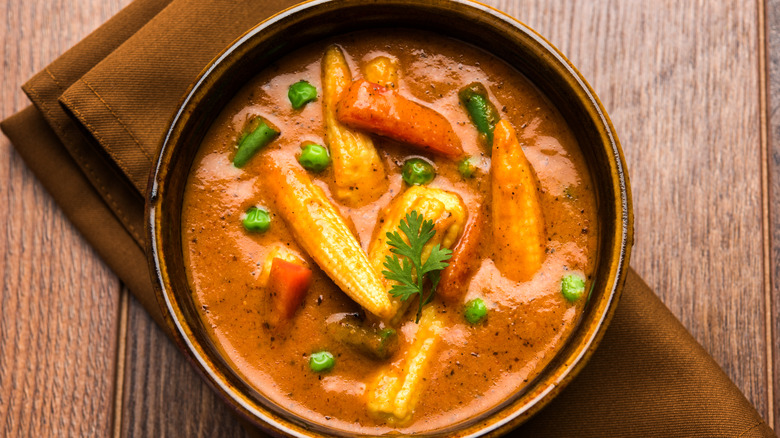11 Ways To Use Canned Baby Corn
Unlike baby carrots, which are really just bite-sized nuggets cut from bigger carrots, baby corn really is just that: young corn. It is harvested before it gets fertilized, which results in an adorable little corn cob that you can eat in one bite. It can be made from any kind of corn and is usually tender when canned and/or cooked ... but what exactly are you supposed to do with it? Lots of things, as it turns out.
It's a little rare in the U.S., but canned baby corn is great to have on hand if you can find it, as there are a myriad of different ways to cook and eat it. You can enjoy it raw, add it to soups, put it in a stir fry, mix it with other vegetables for an appetizer, deep fry it, or pickle it. In this article, we're taking a look at all these ideas — and more. They're all so great that they just might make you say, "Yeah, baby (corn)!"
1. Put it in a salad
Normally, one doesn't think about putting corn in a salad. Sure, there are exceptions to this rule — Mexican street corn salad, for example, is delicious. But most salads stick with the basics, like leafy greens, tomatoes, and croutons. Little corn kernels from regular corn tend to get a bit lost among the leaves and sink to the bottom of the salad bowl. But you won't have this issue with baby corn.
Canned baby corn is perfect for salads because it's large enough to stand on its own. It's more tender than crunchier carrots, but still crisp enough to have a nice bite to it. It doesn't have a strong flavor on its own, so it won't distract from other things in your salad, either. What's more, you don't even have to cook it before mixing it in. Simply open the can, drain the water, and toss it in with the other vegetables. Be sure to add some salt or other flavorings, however, as its natural flavor is very neutral and needs a little help from seasonings or your salad dressing to really pop.
2. Serve it as crudités
One of the best things about baby corn is that you can serve it straight from the can, without any prep or additions. Moreover, while canned vegetables are not normally seen as the height of fanciness, canned baby corn can become positively elegant with the right presentation. Take advantage of its convenience by creating a crudité platter for your next dinner party that will wow even the most sophisticated of your guests.
Crudités, pronounced "kroo-dee-tehs," are raw vegetables arranged on a nice plate, platter, or cutting board. They are usually served with a dipping sauce — crudités are especially tasty with green goddess dressing — or squares of cheese, and are often a light start to what will be a heavier, multi-course meal. You can also serve them as a casual but elevated snack unto itself.
To incorporate canned baby corn into your array of crudités, simply drain the water from the can and pat the mini corn cobs dry if they're still damp. Then, add them to a platter along with other raw fruits and veggies like carrot sticks, cherry tomatoes, bell peppers, grapes, and whatever else tickles your fancy. They go especially well with zingy dipping sauces that incorporate citrus and/or garlic, but honestly, everything tastes pretty good with them.
3. Boil it for a quick side dish
If you've been working all day and are looking to make a quick side dish for your dinner, look no further than canned baby corn. While it's okay to eat baby corn straight from the can, you may like it better after boiling it, which makes it more tender. Just like with regular canned corn, the preparation is simple: Bring a pot of water to a boil on the stove, add the baby corn, and reduce the heat to a simmer, stirring occasionally. When the corn is softer but has not yet become mushy, it is ready to eat.
For baby corn that is a bit crisper, you can blanch it instead. This is very similar to boiling, but takes less time. To do it, bring the pot of water to a boil, but this time only put the baby corn in for 15 seconds. Don't reduce the heat. After this time has passed, drain off the boiling water and plunge the corn into a bowl of ice water for 30 seconds to 1 minute to stop the cooking process. This method is great if you want to avoid your corn getting too mushy or are short on time.
4. Steam it to make an even healthier meal
Did you know that steamed vegetables are healthier than vegetables that have been cooked in other ways? According to a 2009 study, steaming vegetables retains more of their vitamins than boiling them, making this an ideal way to get the nutrients you need. Steamed vegetables also tend to be crisper and have nice, vibrant color.
If you need more convincing, know that steaming baby corn is also quick and easy to do. Place the drained baby corn in a steamer basket and place that basket inside a tall pot with a few inches of water inside (you can also do this with some pressure cookers or a dedicated steamer made of bamboo). Cover the pan and steam your corn until it's still firm in the center, but tender everywhere else. This should only take about 3 to 6 minutes, so keep an eye on it. Once the corn is done, add some seasoning, and voila! You've got a healthy, tasty side dish with lots of delicious nutrients.
5. Add it to your stir fry
One of the best vegetables to use in stir fries is baby corn. Since it doesn't have an overwhelming flavor on its own, it fits in perfectly with other ingredients, like broccoli, snap peas, carrots, and bell peppers. It also goes great in stir fries that include meat, as its mild taste pairs well with umami-rich flavors.
As with other preparation methods on this list, start by draining the water from your canned baby corn — but in this case, you should stop there. Baby corn will almost never be the first ingredient you add to your stir fry. In most cases, you'll heat the oil up in the wok, then add vegetables that take a while to cook like onions, mushrooms, carrots, and peppers. These should be cooked for around 10 minutes, after which you can finally add the canned baby corn. The corn should take around 5 minutes to cook until it's crisp-tender. Once that's ready, you can add the other seasonings and cook everything a bit longer before serving it all over rice.
6. Air fry it along with your chicken
These days, air fryers are trending. It seems like everybody is using them to cook just about everything — so why not canned baby corn? In fact, air fried baby corn is a terrific side dish, especially for air fried chicken. The preparation process is simple. Drain the canned baby corn and put it into a nice big bowl; you want to be able to stir the contents without anything slopping over the sides. Pour on a bit of olive oil and toss the corn to coat it. Then add salt, pepper, and your other chosen seasonings. Place it all in the air fryer basket or tray and air fry it for 15 minutes, stirring it at the midway point.
When your baby corn is officially air fried, place it on a serving tray or dish and drizzle it with other toppings like aioli or chipotle-flavored mayonnaise. You can also add cheese, butter, salsa, or herbs like cilantro or parsley. When it's ready, serve it right alongside your air fried chicken or other air fried meats, and you've got a great weeknight dinner on your hands.
7. Grill your baby corn at your next barbecue
If you've been to a few barbecues, you've probably seen regular-sized grilled corn on the cob. Grilling baby corn would be preposterous, wouldn't it? It's natural to assume it's too tiny to withstand a grill's heat. But in fact, grilling baby corn is totally possible and makes for a simple and delicious side dish for any cook-out. Children especially love the mini corn cobs, as they can eat them and feel like a giant.
So, how can you get that nice, smoked taste without letting the baby corn fall through the slats in the grill? First, get your hands on some heavy duty aluminum foil. Drain the baby corn and spread it in one single flat layer on the foil. Cut up around 1 tablespoon of butter. Sprinkle the cut cubes of butter over the corn, then close up your foil pack, sealing it well around the edges. Put it on the grill for around 15 minutes. Your baby corn will come out as buttery, smoky, and as delicious as its grown-up counterpart.
8. Add it to your roasted vegetables
Another way to use your canned baby corn is to roast it in the oven. You can roast it on its own, of course, but it's even better when it's mixed in with other classic roasted vegetables like potatoes, carrots, or onions. Start by preheating your oven to 400 degrees Fahrenheit and line a baking sheet with a piece of foil. Add your corn and any other vegetables to the tray, then toss them with olive oil and your chosen seasonings. Pop it all in the oven and roast for 15 to 20 minutes, until the corn is lightly browned.
One thing to note with this method of preparation is that not all vegetables cook at the same speed. If you're roasting vegetables like potatoes and carrots, you may need to start cooking those earlier or cut them into smaller pieces so that everything gets thoroughly roasted and finishes at the same time.
9. Toss some baby corn into your vegetable soup
It's not unusual to see corn added to soups, but you may not be expecting to see baby corn in there. We can assure you, however, that this can — and should! — be done. You can use canned baby corn just as you would any other vegetable.
As with most soups, start by cooking the aromatics like onions and garlic, then add meat. Cook these for a while, then add broth and bring to a boil. It's time to start adding the vegetables at this point. Start with the ones that take longer to cook, like potatoes and carrots, then move onto ones like peas and baby corn, which have a more moderate cook time. Depending on the size and shape of the other vegetables in your pot, you may want to cut your baby corn into smaller chunks to make it more manageable. Either way, cover the pot and cook until the vegetables are your desired tenderness (this usually means still lightly crisp).
10. Deep fry it for a decadent side dish
Do you ever get tired of hearing about how healthy vegetables are? How they're so good for you? Allow us to introduce you to deep-fried baby corn. The next time you're making fried chicken, set aside some of the coating for your corn (don't use the same flour on your vegetables that you used on raw chicken, though: You don't want cross-contamination). Boil your baby corn until it's still crisp, but slightly tender. Then drain off the water and add your coating, which you can make using all-purpose flour and your choice of seasonings, or some rice flour for a unique take. Add a little bit of water to turn it into a thick, drippy paste (thin enough to stick to the corn, but not thin enough to slide off). Thoroughly coat each piece of baby corn with it.
Heat up some oil on the stove or in a deep fryer. Once it's hot enough, start frying your corn just like you would your chicken. When it's golden brown on all sides, remove it and let the excess oil drain off before placing on a paper towel to finish drying. Serve it right alongside your fried chicken, or maybe even as a snack with a bit of ketchup or mayonnaise.
11. Put it in a jar and pickle it
If you have a bunch of canned baby corn and are looking for something a bit unorthodox to do with it, we've got an interesting idea: Why not try pickling it? Pickled baby corn can be used in a wide variety of dishes from salads to stir fries; its vinegary taste always brings something new and interesting to the table.
To start, blanch your baby corn. Once it's removed from the water, you can mix in some flavorings like red and green peppers, hot peppers, or garlic. Once you have all your vegetables stirred together well, set them aside and heat up some white vinegar, water, sugar, and pickling salt in a large saucepan on the stove. Boil this liquid for 5 minutes, then add the baby corn and boil for 2 more minutes. Then, fill your jars with the baby corn mixture and the liquid mixture. Follow standard vegetable canning instructions to seal and sterilize the jars. Once that's done, you'll have a neat new pickled vegetable to add to your dishes, or a cool gift to share with your friends, family or coworkers.
